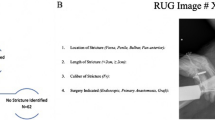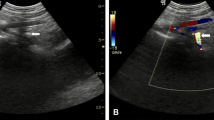Abstract
Purpose
The Post-Ureteroscopic Lesion Scale (PULS) offers a simple grading system for the description of ureteral lesions after ureteroscopy. In this article, we present the results of a video-based multicenter evaluation of the inter-rater reliability of clinically important PULS grades 0–3.
Methods
Video sequences at the end of ureteroscopy (final passage) were recorded for 100 consecutive patients at a single institution and assessed by experienced urologists (n = 20) and senior residents (n = 17) at 19 international centers. The cohort included only patients with lesions grades 0–3 (with grades 2 and 3 subsumed as 2 + since distinction is defined by an extravasation of contrast medium in fluoroscopy). The gradings were evaluated for inter-rater reliability and in terms of simplicity, validity, comprehensibility, reproducibility, and usefulness.
Results
Overall, inter-rater reliability was high (Kendall’s W = 0.69, p < 0.001) and was comparable between specialists (Kendall’s W = 0.69, p < 0.001) and residents (Kendall’s W = 0.71, p < 0.001). The matched ratings showed grade 0 in 43.0 % of patients and grades 1 or 2 + in 44.0 and 13.0 % of patients, respectively. Results of the questionnaires indicated a high degree of acceptance, with an overall rating of 1.76 (1.64–1.93 for different items, scale 1–6).
Conclusions
Inter-rater reliability of the endoscopically assessable PULS was high among urologists with different levels of experience in different countries worldwide. The validated PULS system may be used for standardized reporting of ureteral lesions/injuries after ureteroscopy. In addition, PULS will enable more selective standardization of indications for postoperative DJ stenting based on the randomized controlled trials.



Similar content being viewed by others
Abbreviations
- PULS:
-
Post-Ureteroscopic Lesion Scale
References
Matlaga BR, Jansen JP, Meckley LM, Byrne TW, Lingeman JE (2012) Treatment of ureteral and renal stones: a systematic review and meta-analysis of randomized, controlled trials. J Urol 188(1):130–137
Johnson GB, Portela D, Grasso M (2006) Advanced ureteroscopy: wireless and sheathless. J Endourol 20(8):552–555
Geavlete P, Georgescu D, Nita G, Mirciulescu V, Cauni V (2006) Complications of 2735 retrograde semirigid ureteroscopy procedures: a single-center experience. J Endourol 20(3):179–185
Bader MJ, Sroka R, Gratzke C, Seitz M, Weidlich P, Staehler M, Becker A, Stief CG, Reich O (2009) Laser therapy for upper urinary tract transitional cell carcinoma: indications and management. Eur Urol 56(1):65–71
Breda A, Ogunyemi O, Leppert JT, Schulam PG (2009) Flexible ureteroscopy and laser lithotripsy for multiple unilateral intrarenal stones. Eur Urol 55(5):1190–1196
Perlmutter AE, Talug C, Tarry WF, Zaslau S, Mohseni H, Kandzari SJ (2008) Impact of stone location on success rates of endoscopic lithotripsy for nephrolithiasis. Urology 71(2):214–217
Schoenthaler M, Wilhelm K, Katzenwadel A, Ardelt P, Wetterauer U, Traxer O, Miernik A (2012) Retrograde intrarenal surgery in treatment of nephrolithiasis: is a 100 % stone-free rate achievable? J Endourol 26(5):489–493
Haleblian G, Kijvikai K, de la Rosette J, Preminger G (2008) Ureteral stenting and urinary stone management: a systematic review. J Urol 179(2):424–430
Schoenthaler M, Wilhelm K, Kuehhas FE, Farin E, Bach C, Buchholz N, Miernik A (2012) Postureteroscopic lesion scale: a new management modified organ injury scale—evaluation in 435 ureteroscopic patients. J Endourol 26(11):1425–1430
Dindo D, Demartines N, Clavien PA (2004) Classification of surgical complications: a new proposal with evaluation in a cohort of 6336 patients and results of a survey. Ann Surg 240(2):205–213
Moore EE, Cogbill TH, Jurkovich GJ, McAninch JW, Champion HR, Gennarelli TA, Malangoni MA, Shackford SR, Trafton PG (1992) Organ injury scaling. III: chest wall, abdominal vascular, ureter, bladder, and urethra. J Trauma 33(3):337–339
Lynch TH, Martinez-Pineiro L, Plas E, Serafetinides E, Turkeri L, Santucci RA, Hohenfellner M (2005) EAU guidelines on urological trauma. Eur Urol 47(1):1–15
Rioja J, Mamoulakis C, Sodha H, Suwijn S, Laguna P, de la Rosette J (2011) A plea for centralized care for ureteroscopy: results from a comparative study under different conditions within the same center. J Endourol 25(3):425–429
Tefekli A, Ali Karadag M, Tepeler K, Sari E, Berberoglu Y, Baykal M, Sarilar O, Muslumanoglu AY (2008) Classification of percutaneous nephrolithotomy complications using the modified clavien grading system: looking for a standard. Eur Urol 53(1):184–190
Yoon PD, Chalasani V, Woo HH (2013) Use of Clavien-Dindo classification in reporting and grading of complications after urologic surgical procedures: analysis of 2010–2012. J Urol 190(4):1271–1274
Tepeler A, Resorlu B, Sahin T, Sarikaya S, Bayindir M, Oguz U, Armagan A, Unsal A (2013) Categorization of intraoperative ureteroscopy complications using modified Satava classification system. World J Urol 17:17
Traxer O, Thomas A (2013) Prospective evaluation and classification of ureteral wall injuries resulting from insertion of a ureteral access sheath during retrograde intrarenal surgery. J Urol 189(2):580–584
Pengfei S, Yutao L, Jie Y, Wuran W, Yi D, Hao Z, Jia W (2011) The results of ureteral stenting after ureteroscopic lithotripsy for ureteral calculi: a systematic review and meta-analysis. J Urol 186(5):1904–1909
Nabi G, Cook J, N’Dow J, McClinton S (2007) Outcomes of stenting after uncomplicated ureteroscopy: systematic review and meta-analysis. BMJ 334(7593):20
Makarov DV, Trock BJ, Allaf ME, Matlaga BR (2008) The effect of ureteral stent placement on post-ureteroscopy complications: a meta-analysis. Urology 71(5):796–800
Acknowledgments
We would like to acknowledge and extend our heartfelt gratitude to the other members of the PULS working group for contributing substantially to this work: Alessio Anghileri (Ospedale Manzoni Lecco, Department of Urology, Lecco, Italy), Jawad Feghali (Lenox Hill Hospital, Department of Urology, New York, USA), Ioannis Georgiopoulos (University of Patras Medical School, Department of Urology, Patras, Greece), Katharina Hauner (Technische Universität München, Klinikum rechts der Isar, Department of Urology, Munich, Germany), John Henderson (University of Oxford, The Churchill Hospital, Nuffield Department of Surgical Sciences, Department of Urology, Oxford, United Kingdom), Manuela Hiess (St. John of God Hospital, Teaching Hospital of the Medical University of Vienna, Department of Urology, Vienna, Austria), Imran Khan Jalbani (AGA Khan University Hospital, Department of Surgery and Urology, Karachi, Pakistan), Katharina Kaftan (University Hospital Rostock, Department of Urology, Rostock, Germany), Florian Kurtz (Technische Universität München, Klinikum rechts der Isar, Department of Urology, Munich, Germany), Julien Letendre (Tenon University Hospital, Department of Urology, Paris, France), Søren Kissow Lildal (University of Southern Denmark, Department of Urology, Hospital Littlebelt, Fredericia, Denmark), Gabriele Lotter (University of Regensburg, Caritas-Hospital St. Josef, Regensburg, Germany), António Garcias Soares (Universidade Católica Portuguesa, Department of Urology, Lisboa, Portugal), Stephanie Tatzel (Western University, St Joseph’s Hospital, Department of Urology, London, Ontario, Canada), Antonopoulos Theodosios (Siloah St. Trudpert Hospital, Department of Urology, Pforzheim, Germany), Christian Tiburtius (Asklepios Klinik Barmbek, Department of Urology, Hamburg, Germany).
Conflict of interest
All authors declare no conflict of interest.
Author information
Authors and Affiliations
Corresponding author
Rights and permissions
About this article
Cite this article
Schoenthaler, M., Buchholz, N., Farin, E. et al. The Post-Ureteroscopic Lesion Scale (PULS): a multicenter video-based evaluation of inter-rater reliability. World J Urol 32, 1033–1040 (2014). https://doi.org/10.1007/s00345-013-1185-1
Received:
Accepted:
Published:
Issue Date:
DOI: https://doi.org/10.1007/s00345-013-1185-1




